American Bitterns and Green Herons, two captivating wading bird species found in North American wetlands, share not only the tranquil waters they inhabit but also a fascinating array of characteristics that define their distinct identities.
From their nuanced plumage to their cunning hunting strategies, these avian residents of marshes and riversides exhibit an intriguing interplay between adaptation and environment.
Exploring the diverse behaviors, features, and behaviors of these birds provides a lens through which we can appreciate the intricate relationships between form, function, and survival in the intricate tapestry of wetland ecosystems.
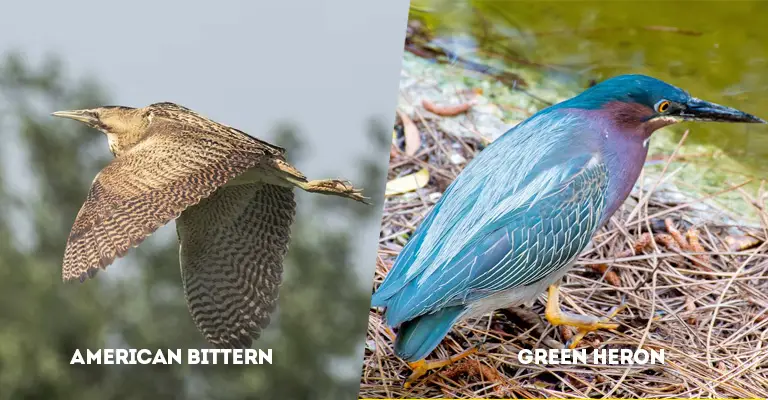
Key Differences Between American Bittern and Green Heron
American Bittern and Green Heron are two distinct bird species found in North America, and they have several key differences in terms of appearance, behavior, and habitat.
Here are some of the main differences between them:
Size
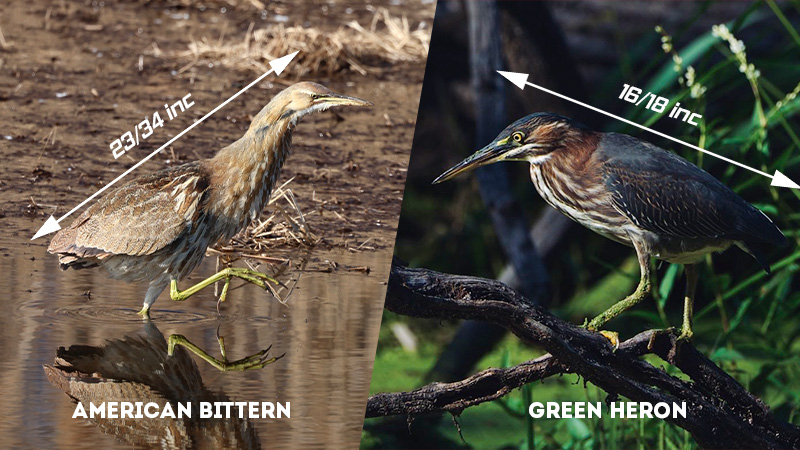
- American Bittern: American Bitterns are notably larger, measuring between 23 to 34 inches (58 to 86 cm) in length, with a wingspan of around 41 to 51 inches (104 to 130 cm).
Their larger size contributes to their ability to navigate larger wetland areas and their distinctive appearance when compared to other wading bird species. - Green Heron: In contrast, Green Herons are smaller, with an average length of 16 to 18 inches (40 to 46 cm) and a wingspan of about 25 to 27 inches (64 to 69 cm).
This compact size allows them to efficiently hunt in more confined spaces within their wetland habitats, using their stealthy approach to catch prey.
Plumage
- American Bittern: The American Bittern displays a cryptic and subtle plumage pattern, consisting of streaked brown and buff feathers.
This mottled coloring blends seamlessly with the reeds and grasses of its marshy habitats, providing effective camouflage.
The intricate patterning helps these birds remain inconspicuous as they stand among the vegetation, waiting for their prey. - Green Heron: Conversely, the Green Heron boasts a more vibrant and distinctive plumage. Its back features a dark greenish-brown hue that can appear iridescent under certain lighting conditions.
This coloring, combined with its rusty-brown neck and a dark cap atop its head, sets the Green Heron apart from other wading birds. The heron’s eye-catching plumage aids in quick identification and adds to its allure in wetland environments.
Neck and Head
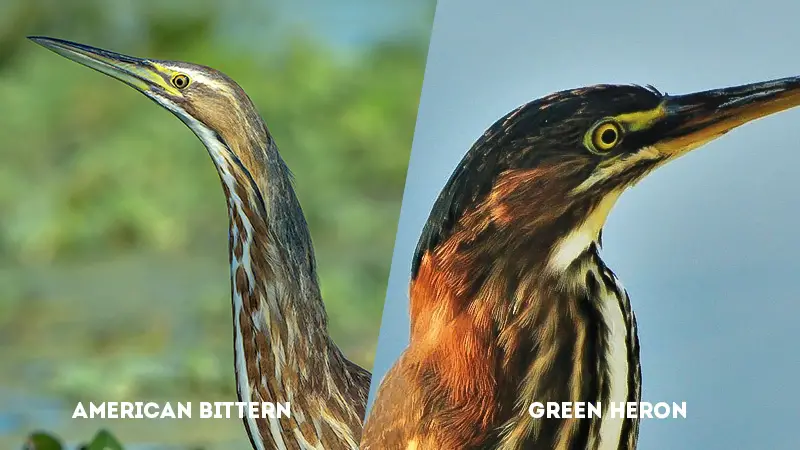
- American Bittern: American Bitterns possess a relatively long neck and a distinct mottled pattern that extends from the neck to the upper body. Their head appears somewhat flattened, and their long, pointed bill facilitates their hunting strategies.
This combination of features aligns with their reclusive behavior, as they stretch their necks upward while standing amid the vegetation to resemble the surrounding plant life. - Green Heron: The Green Heron’s neck is notably shorter in comparison to that of the American Bittern. The bird’s head has a rounded shape, contrasting with the flattened appearance of the Bittern’s head.
These features contribute to the Green Heron’s ability to execute its stealthy hunting methods. Its shorter neck aids in precise strikes as it waits patiently at the water’s edge, ready to snatch prey with its sharp bill.
Camouflage Behavior
- American Bittern: American Bitterns are renowned for their exceptional camouflaging behavior. When they feel threatened, they elongate their necks and point their bills skyward, mimicking the surrounding vegetation.
This behavior, known as the “bittern pose,” effectively conceals them from potential predators by blending their form with the reeds and grasses, making them difficult to spot. - Green Heron: Green Herons adopt an alternative approach to concealment. Rather than extending their necks, they utilize patience and stealth in their hunting tactics.
They perch near the water’s edge, immobile and focused, waiting for the ideal moment to launch a rapid strike at unsuspecting fish or insects. This stillness, combined with their intricate coloring, enables them to remain concealed until the opportune instant to catch prey.
Vocalization
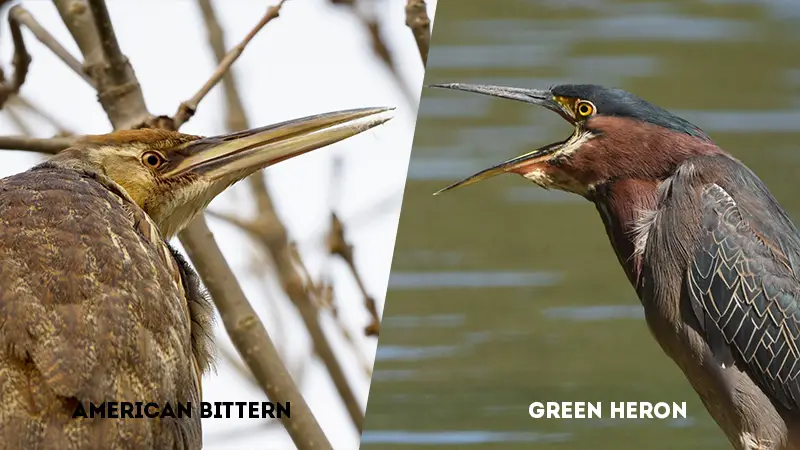
- American Bittern: The American Bittern’s vocalization is distinctive, consisting of a resonant “pump-er-lunk” call, which is particularly pronounced during the breeding season.
This sound resembles the mechanical pumping of a water source and can be heard over long distances. The call helps establish territory and attracts potential mates. - Green Heron: In contrast, the Green Heron produces a loud and sharp “skeow” or “kyow” call. This vocalization serves various purposes, including communication within their territories and interactions with other members of their species.
The call is not only an auditory identifier for the Green Heron but also a notable feature of wetland soundscapes.
Habitat
- American Bittern: American Bitterns favor a range of wetland habitats, including marshes and reedy areas. They often inhabit dense vegetation near the water’s edge, where their cryptic plumage aids in blending into the surroundings.
These wetlands provide ample cover and suitable foraging grounds for their diet of fish, amphibians, and insects. - Green Heron: Green Herons thrive in diverse wetland settings, such as ponds, riversides, and swamps.
They are often found perched on vegetation overhanging the water, waiting for prey to come within striking distance. The vegetation provides both cover and a vantage point for their patient hunting approach.
Feeding Style
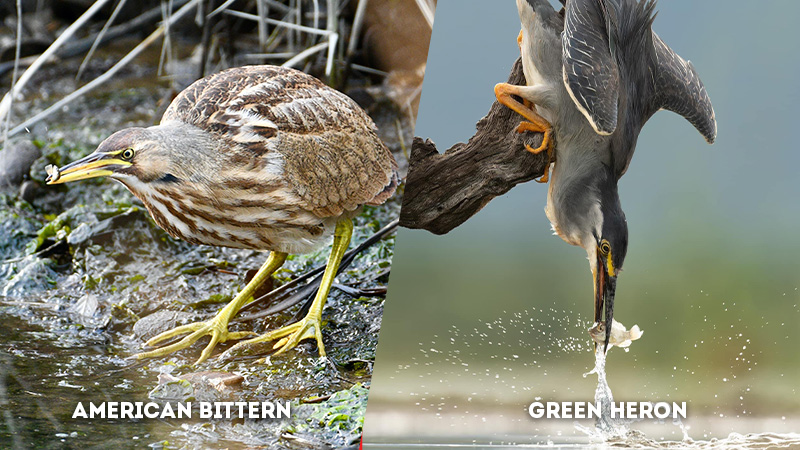
- American Bittern: American Bitterns employ a striking feeding technique. From their concealed positions amid the reeds, they suddenly extend their long necks and swiftly thrust their bills into the water to seize fish and aquatic invertebrates. This ambush strategy takes advantage of their camouflaging and surprise element.
- Green Heron: Green Herons exhibit a patient and stealthy feeding style. They perch motionless on branches or vegetation above water, carefully observing their surroundings. When an opportunity arises, they deliver a rapid and accurate strike to capture small fish, insects, and even amphibians.
Migration
- American Bittern: Migration patterns for American Bitterns can be complex, with some populations migrating in response to weather conditions and food availability. While some are year-round residents, others undertake seasonal migrations to reach more favorable habitats.
- Green Heron: Green Herons also exhibit varying migration behaviors. Some individuals are migratory, moving to warmer regions during colder months, while others remain resident throughout the year in their chosen habitats.
Breeding Behavior
- American Bittern: American Bitterns construct platform nests made of reeds and vegetation within their wetland habitats.
These nests are carefully situated among the vegetation to provide both camouflage and protection. They engage in courtship displays and vocalizations during the breeding season to attract mates. - Green Heron: Green Herons take a different nesting approach by building their nests in trees or shrubs close to water bodies. They lay eggs in nests constructed with twigs and leaves, providing a safe space for their young. Courtship involves elaborate behaviors, including stretching their necks and crest feathers.
Leg Color
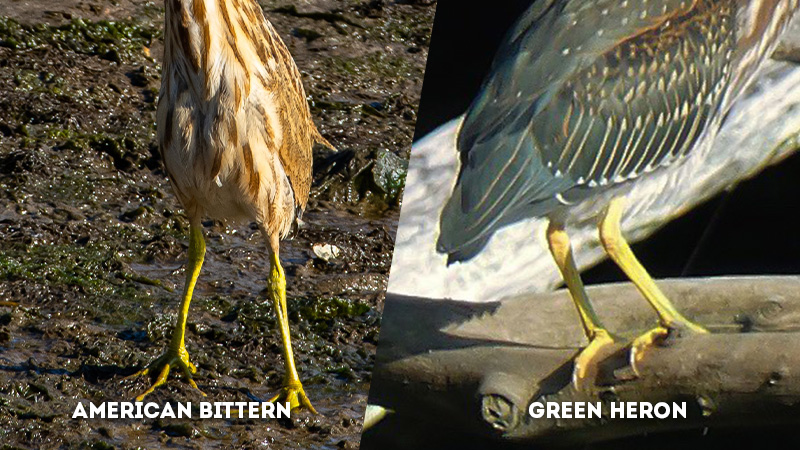
- American Bittern: American Bitterns typically have yellowish-green legs, which can sometimes be obscured by the vegetation they inhabit. The coloration of their legs complements their overall camouflage, aiding in their ability to blend into their wetland surroundings.
- Green Heron: Green Herons have distinctive orange-to-yellow legs that stand out against their dark plumage. This leg coloration is an additional identifying feature, especially when combined with their other unique characteristics.
Bill Shape
- American Bittern: The American Bittern possesses a long and pointed bill that is well-suited for its feeding strategy. This bill shape allows them to swiftly strike at their prey from a concealed position within the reeds. The elongated bill aids in grasping fish, amphibians, and insects with precision.
- Green Heron: Green Herons are characterized by their short and sharp bills. This bill shape is ideal for their patient hunting approach, enabling them to swiftly grasp and capture small fish, insects, and other aquatic prey items.
Bill Color
- American Bittern: The bill of the American Bittern typically displays pale yellow to grayish hues. This coloration complements their overall plumage and camouflage strategy, aiding in their concealment within the reeds and vegetation.
- Green Heron: In contrast, the Green Heron’s bill is dark in color, often blackish or dark gray. The dark bill stands out against their vibrant plumage, adding to their distinctive appearance and making their facial features more noticeable.
Back Pattern
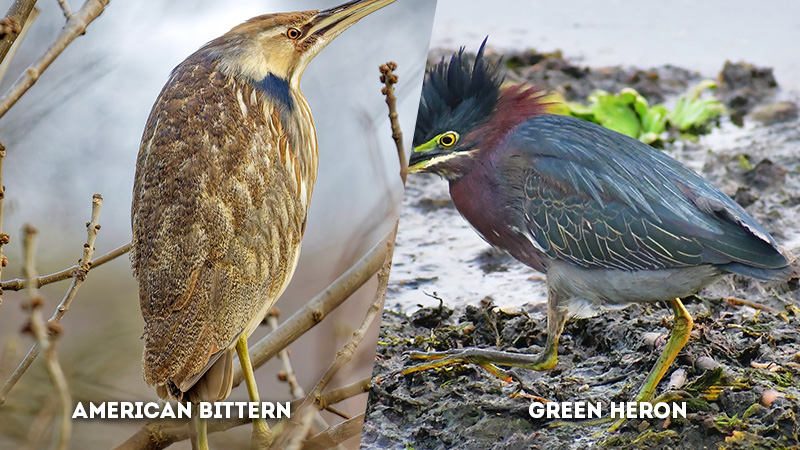
- American Bittern: American Bitterns showcase a streaked and cryptic back pattern. This patterning blends with the reeds and grasses of their marshy habitats, providing effective camouflage as they stand among the vegetation.
- Green Heron: The back pattern of the Green Heron consists of a uniform dark greenish-brown color, which can appear iridescent under certain lighting conditions. This distinct coloration adds to the Green Heron’s visual appeal and sets it apart from other wading birds.
Neck Color
- American Bittern: The neck of the American Bittern features a mottled and streaked pattern that matches its overall cryptic plumage. This blending of colors aids in their camouflage as they position themselves among the reeds and grasses.
- Green Heron: Green Herons exhibit a rusty-brown neck with a unique dark cap atop their head. This contrasting neck color and cap are key identifying features that differentiate them from other wading birds and contribute to their striking appearance.
Head Shape
- American Bittern: The American Bittern’s head has a somewhat flattened appearance, contributing to its ability to remain inconspicuous among the vegetation. This head shape aligns with their camouflaging behavior, where they extend their necks upward to resemble the surrounding plant life.
- Green Heron: The head of the Green Heron has a more rounded shape compared to the flattened head of the American Bittern. This head shape, combined with their other features, allows them to effectively observe their surroundings while hunting from perches.
Behavioral Adaptations
- American Bittern: The American Bittern’s primary behavioral adaptation is its remarkable camouflage behavior. By stretching their necks and pointing their bills upward, they mimic surrounding vegetation, effectively blending into their wetland habitats.
This behavior helps them avoid detection by predators and enables them to ambush prey with precision. - Green Heron: Green Herons have developed a stealthy hunting strategy. They remain motionless on branches or vegetation, patiently observing their surroundings before launching quick and accurate strikes at prey.
This stillness and patience, combined with their distinctive plumage, make them efficient predators in wetland environments.
Migration Behavior
- American Bittern: Migration patterns of American Bitterns vary across populations. While some are migratory and move to more favorable habitats during colder months, others are more sedentary, staying in their wetland habitats year-round.
- Green Heron: Similar to American Bitterns, Green Herons also exhibit mixed migration behaviors. Some individuals undertake seasonal migrations to escape harsh weather conditions, while others remain in their habitats throughout the year.
Habitat Preferences
- American Bittern: American Bitterns inhabit a range of wetland habitats, including marshes and reedy areas. These habitats provide ample cover and food sources for their survival and reproduction.
- Green Heron: Green Herons thrive in diverse wetland environments, such as ponds, riversides, and swamps. They prefer habitats with both water and suitable perching spots from which they can hunt.
Juvenile Differences
- American Bittern: Juvenile American Bitterns resemble their adult counterparts closely, with cryptic plumage and streaked patterns. Their behavior of mimicking vegetation for camouflage is also evident from a young age.
- Green Heron: Juvenile Green Herons share similarities with adult Green Herons but can be distinguished by their smaller size, darker cap, and reddish neck. These differences help differentiate them from juvenile and adult American Bitterns.
Conservation Status
- American Bittern: The conservation status of American Bitterns varies by region, but they generally hold a status of “Least Concern” in terms of conservation. However, habitat loss, wetland degradation, and human disturbances can impact their populations in some areas.
- Green Heron: Similarly, Green Herons are generally classified as “Least Concern” in terms of conservation status. Their adaptability to various wetland habitats and their relatively stable populations contribute to their conservation status.
American Bittern vs. Green Heron: Comparison Table
| Feature | American Bittern | Green Heron |
|---|---|---|
| Size | Larger (23-34 in / 58-86 cm) | Smaller (16-18 in / 40-46 cm) |
| Plumage | Cryptic streaked brown and buff | Dark greenish-brown with iridescence |
| Neck and Head | Mottled pattern; Flattened head; Long bill | Short neck; Rounded head |
| Camouflage Behavior | Extends neck upward to blend in | Stealthy, patient hunting behavior |
| Vocalization | “Pump-er-lunk” call during breeding | Loud “skeow” or “kyow” call |
| Habitat | Marshes, wetlands, reedy areas | Wetlands, ponds, riverside vegetation |
| Feeding Style | Striking prey from reeds or grasses | Patiently waiting for fish and insects |
| Migration | Migratory in some regions | Generally resident year-round |
| Breeding Behavior | Builds platform nests in reeds | Nests in trees or shrubs near water |
| Leg Color | Yellowish-green | Orange to yellow |
| Bill Shape | Long and pointed | Short and sharp |
| Bill Color | Pale yellow to gray | Dark |
| Back Pattern | Streaked and cryptic | Uniform, often with iridescence |
| Neck Color | Mottled and streaked | Rusty-brown with a distinct cap |
| Head Shape | Flattened appearance | Rounded shape |
| Behavioral Adaptations | Camouflage behavior for protection | Stealthy hunting strategies |
| Migration Behavior | Migratory in response to weather and food | Some migration, variable among populations |
| Habitat Preferences | Wide range of wetlands | Favorable habitats near water sources |
| Juvenile Differences | Tend to resemble adults closely | Some migration, variables among populations |
| Conservation Status | Least Concern (varies by region) | Least Concern (varies by region) |
Frequently Asked Questions
American Bitterns rely on their exceptional camouflage behavior to defend themselves from predators. When threatened, they elongate their necks, point their bills skyward, and freeze in a posture that resembles the surrounding vegetation. This makes them difficult to spot and offers protection from potential dangers.
Yes, Green Herons are versatile hunters with adaptable techniques. While they mainly feed on fish and insects, their hunting methods vary. Fish, often use their sharp bills to swiftly strike from above. For insects, they may use a more deliberate stalking approach, using their sharp vision to detect and capture prey.
Vocalizations serve crucial roles in communication and interactions among both species. American Bitterns’ distinctive “pump-er-lunk” call establishes territorial boundaries and attracts potential mates. Green Herons use their “skeow” or “kyow” calls for various purposes, including maintaining contact with their family members and other herons in their vicinity.
Juvenile American Bitterns and Green Herons learn their hunting skills through observation and practice. They typically accompany adult birds during hunting sessions, observing their techniques and behavior. Over time, they develop the necessary skills and techniques to become successful predators themselves.
While both American Bitterns and Green Herons are currently classified as “Least Concern,” they do face challenges. Habitat loss due to urbanization, wetland degradation, and pollution can impact their populations. Climate change may also alter their habitats and food availability, potentially affecting their migration patterns and survival strategies.
To Recap
In the intricate realm of North American wetlands, the American Bittern and Green Heron stand as emblematic examples of nature’s adaptability and diversity.
As we delve into their differences and similarities from plumage to hunting tactics we uncover the finely tuned strategies they’ve developed to navigate their aquatic homes.
Through their mastery of camouflage, unique vocalizations, and distinctive behaviors, these birds paint a vivid picture of the delicate balance between survival and the environment.
By studying their lives, we gain a deeper understanding of the intricate web of life that thrives in these precious ecosystems.